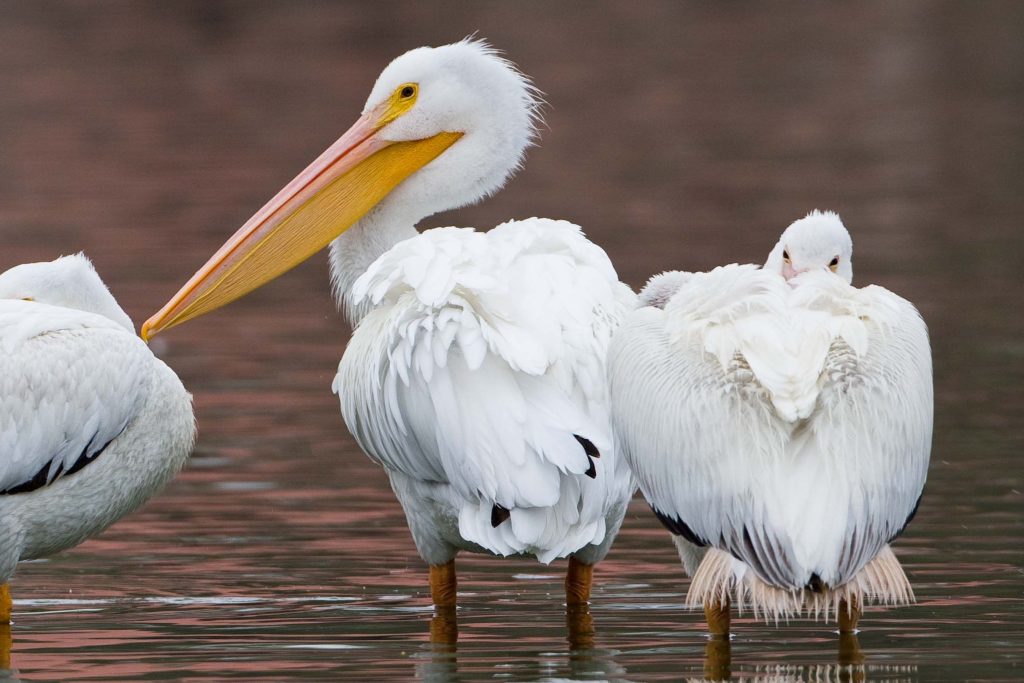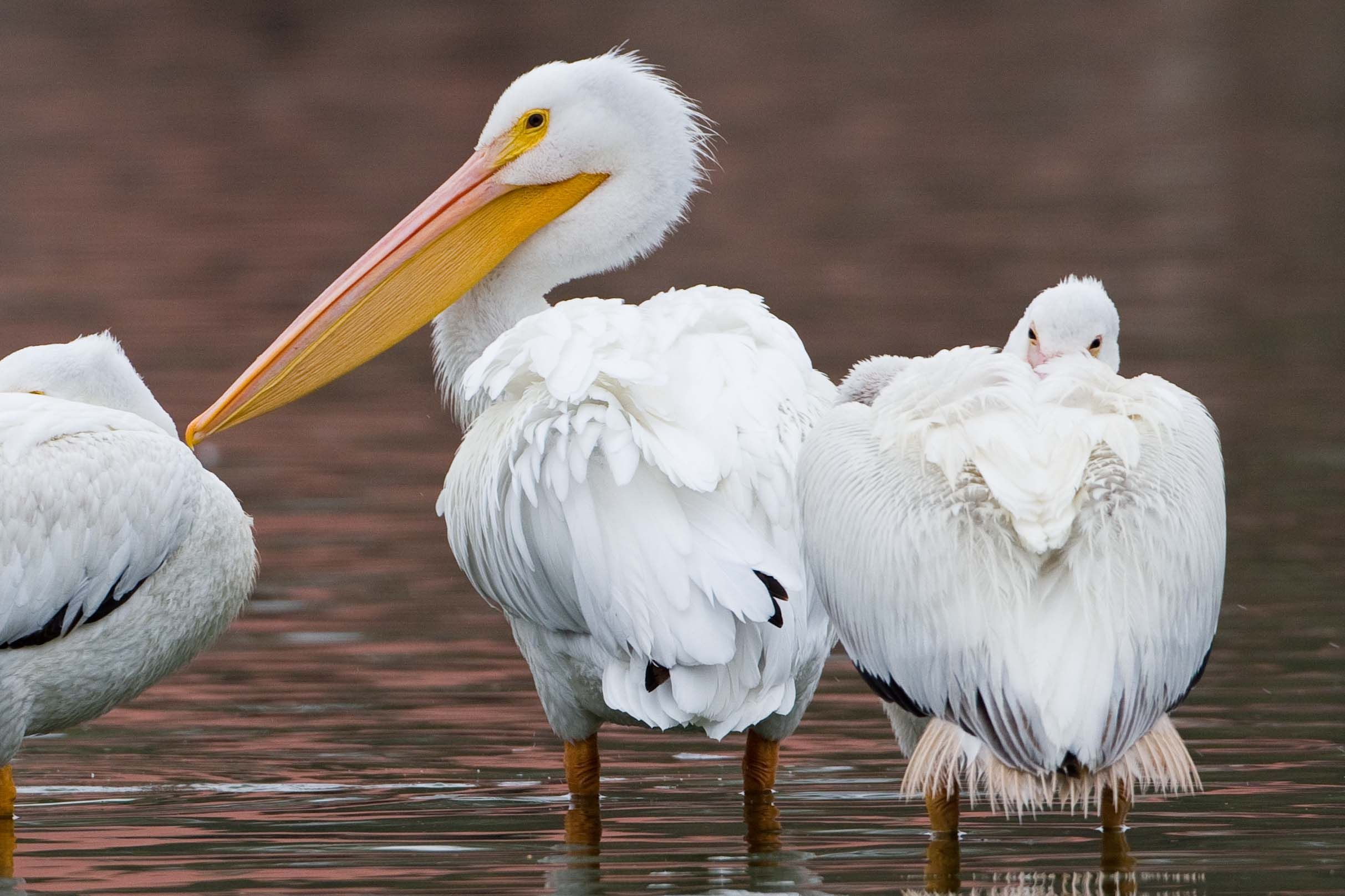In North Dakota, both the American White Pelican and the Brown Pelican, two distinct species of Pelican, can be observed. The American White Pelican is commonly seen during the summer months, while the presence of the Brown Pelican in North Dakota is considered rare or accidental.
Pelicans, known for their massive bills, throat pouches, and feet, stand out as one of the largest bird species globally. Despite their size, they are surprisingly lightweight, thanks to air pockets in their skeleton and skin, which aid in buoyancy. Their elongated wings enable graceful soaring during flight.
Globally, there are eight pelican species, with two of them residing in North America: the American White Pelican and the Brown Pelican.
During the breeding season, pelicans undergo striking changes in their facial skin, throats, and bills, which become more vibrant in color. Some even develop additional structures on their bills.
Pelicans exhibit a communal breeding behavior, forming colonies that can include up to 50,000 birds. Depending on the species, they may nest either on the ground or in trees. After spending around 25 days in the nest, young pelicans gather in groups called “creches,” consisting of up to 100 individuals. Remarkably, parents can recognize and exclusively feed their own chicks.
Although pelicans prey on various animals, they are not classified as birds of prey, as that term is reserved for raptors. Their diet primarily consists of fish, although they also consume crabs, frogs, snakes, mammals, birds, and insects.
To catch fish, pelicans employ their distinctive throat pouch, which allows them to capture their prey and drain the water before swallowing it. Juvenile pelicans may directly feed from their parents’ throat pouch.
This informative guide focuses on identifying the pelican species found in North Dakota, utilizing data gathered from bird watchers on ebird and information sourced from avibase to provide accurate sighting information.
Two Pelican Species in North Dakota:
American White Pelican

During the breeding season, American White Pelicans are prevalent in North Dakota and can be observed from April to November. Around 15% of the summer checklists submitted by bird watchers in the state record their presence.
American White Pelicans, renowned for their soaring abilities, boast the second-largest average wingspan among all North American birds.
Non-breeding adult American White Pelicans feature an entirely white plumage, with black flight feathers visible during flight or when their wings are outstretched. They possess bluish-gray eyes and yellow facial skin surrounding the eyes. Their bills, pouches, and feet have a pale orange hue. Juveniles exhibit light gray feathers with darker brown napes.
Breeding adult American White Pelicans display distinct coloration compared to non-breeding adults. They develop a yellow plate on their upper bills, resembling a horn. While their bodies remain all-white, their eyes, bills, legs, and feet become a brighter shade of orange.
American White Pelicans experience molting changes referred to as “eclipse.” In spring, a visible yellowish patch appears on their breast and chest, while blackish feathers emerge on their heads during summer.
- American White Pelican eclipse
- Flying American White Pelicans (Pelecanus erythrorhynchos)
- American White Pelican in flight
- Pelecanus erythrorhynchos
- Length: 60 – 63 inches (152 – 160 cm)
- Weight: 246.4 ounces (6983 g)
- Wingspan: 96 – 110 inches (244 – 279 cm)
American White Pelicans breed in remote inland lakes across North America before migrating to
the southern Pacific Coast of the United States, the Gulf of Mexico, Mexico, and Central America for winter. They can also be spotted during migration in various western and central U.S. states.
You can find American White Pelicans in shallow freshwater lakes, wetlands, and along the edges of lakes and rivers. During winter, they can be seen in coastal bays, inlets, and estuaries, where they forage in shallow water and rest on sandbars.
Fish constitute the primary food source for American White Pelicans. They swim on the water’s surface and employ their massive bills to capture prey. Additionally, they engage in group foraging, employing strategic and coordinated efforts to drive fish toward the shore, facilitating efficient scooping.
American White Pelicans also demonstrate opportunistic feeding habits, traveling long distances to find more abundant feeding grounds. They may consume crayfish, amphibians, salamanders, and are known to pilfer fish from other birds on the water’s surface.
Regarding vocalization, American White Pelicans are typically silent, emitting only a few grunts. However, young pelicans within large colonies can be quite noisy as they beg for food.
The nests of American White Pelicans consist of simple, shallow depressions on the ground. Additional materials like twigs, sticks, reeds, and other items are added for protection. The female lays one to two eggs, which are incubated by both parents for approximately thirty-six days. Unfortunately, due to siblicide (when one sibling kills another), only one chick per nest typically survives.
Fun Fact: The impressive bill of the American White Pelican can hold up to three gallons of water. When the pelican scoops up fish, it tilts its bill downward to drain the water, enabling it to consume the remaining fish within its throat sac.
Brown Pelican

While sightings of Brown Pelicans in North Dakota are exceptionally rare, the North Dakota Bird Records Committee has acknowledged them as accidental species within the state.
Non-breeding adult Brown Pelicans typically feature white heads and necks with pale yellow foreheads. Their long bills display a combination of yellow and orange hues. Their bodies exhibit a grayish-brown coloration, complemented by short, black legs and webbed feet. Juveniles possess brown heads, necks, backs, and wings, with bluish-gray bills. Their underparts are light brown.
The Brown Pelican comprises five subspecies, two of which breed in the United States. The Pacific Coast variant is known as P.o.californicus, while the Atlantic Coast variant is named P.o.carolinensis.
Distinguishing between Pacific and Atlantic Brown Pelicans becomes more apparent during the breeding season. Both species exhibit white heads with brighter yellow foreheads. However, their nape coloration differs, transitioning from white to dark brown. Atlantic Brown Pelicans possess olive-brown throat pouches, while Pacific Brown Pelicans display red skin in their throat pouch area.
- Brown Pelican – Pacific
- Atlantic Brown Pelican Bird
- Brown Pelican – Atlantic
- Pelecanus occidentalis
- Length: 48 – 50 inches (122 – 127 cm)
- Weight: 131.2 ounces (3718 g)
- Wingspan: 78 – 84 inches (198 – 213 cm)
Brown Pelicans either breed, migrate, or reside year-round along the Pacific and Atlantic Coasts of North America, extending into northern South America.
You can find Brown Pelicans in shallow water environments. They inhabit estuaries and coastal marine habitats year-round. They can
also be observed resting on mangrove islets, sandbars, breakwaters, and offshore rocks.
Brown Pelicans possess a unique foraging ability that sets them apart. They are capable of diving into deep ocean waters to capture prey within their throat pouches. Upon resurfacing, they drain the water, allowing immediate consumption of their catch.
Their diet primarily consists of fish species like sardines and herring. When not diving, they casually swim and seize prey using their bills. They may also consume crustaceans, amphibians, eggs, and young birds.
Brown Pelican vocalizations are typically minimal, with adults usually remaining silent, aside from occasional grunts. Juveniles, on the other hand, may emit squawking sounds while begging for food.
Brown Pelican nests are more commonly found on the ground, rather than in trees. They tend to be concealed and protected on islands, within mangroves, or on cliffs. Nests are constructed by the female using reeds, leaves, pebbles, sticks, and packed soil. The female lays two to four eggs, which are incubated by both parents for approximately a month.
Fun Fact: Brown Pelicans incubate their eggs by covering them with their webbed feet. However, this practice proved detrimental to the species in the past when the pesticide DDT resulted in thinning eggshells that broke under the weight of their parents’ feet. Extensive conservation efforts were required to restore Brown Pelican populations.
